| Pages:
1
..
3
4
5
6
7
..
13 |
jdowning
Oud Junkie
    
Posts: 3485
Registered: 8-2-2006
Location: Ontario, Canada
Member Is Offline
Mood: No Mood
|
|
The attached images are of a modern replica of an early wound silk Chinese qin (zither) string (I don't know who made it). The string is worn out so
the windings loose and separating but, nevertheless, it gives a good idea about the string construction.
It can be seen that the big difference between a modern wire wound string and the early Chinese silk wound strings is that the silk winding of the
latter is flattened (like a tape) producing a smooth surface as well as adding mass to the string.
The string wrapping tool used by the early Chinese string makers is represented by the attached sketch - a copy of a low resolution image of the
original wood cut for clarity.
The tool is carved from a heavy hardwood (with a metal weight added if necessary (for added inertia). The wrapping material (made of six threads) is
wound onto a bobbin and is fed between two round metal rods (mounted closely together) in order to flatten the wrapping as it is wound onto the string
core - very important according to the early Chinese texts "as everything depends on this". (The wrapping must not be round in section).
In practice, the string core - about 12 feet (3.7 metres ) in length - is stretched tight between two posts with the wrapping tool riding on the
string. The tool is then made to rotate around the string by shaking the string (like a skipping rope) causing the wrapping to be wound tightly over
the string core.
Clearly, making a wound string with this simple tool must have been a highly skilled operation in order to achieve the required dimensions and tension
of the wrapping to produce a string that was "uniform without scars".
The ancient Chinese were familiar with geared drives so one has to wonder why they did not wind the strings on a machine similar to those used by
modern string makers? Possibly because the winding had to proceed relatively slowly and exactly to ensure a uniform, smooth string surface and avoid
over stressing and breaking the wrapping?
(The early texts provide instructions on how to repair the wrapping in the event of breakage).
The early Chinese texts and translations can be found on John Thompson's website at
http://www.silkqin.com
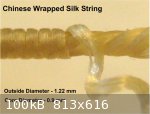
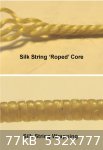
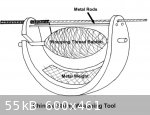
|
|
|
jdowning
Oud Junkie
    
Posts: 3485
Registered: 8-2-2006
Location: Ontario, Canada
Member Is Offline
Mood: No Mood
|
|
The composition and properties of the glue binder necessary for making silk strings is a critical factor so some time has been spent in recent months
in reviewing the possibilities before proceeding further with these string making trials.
The ancient Chinese string makers used raw silk (filament silk with the sericin gum coating left intact). The raw silk filament was first twisted -
rope like - into a string, the string wound onto a wooden cylinder and then immersed in a bath of hot glue until the glue had been fully absorbed by
the string. The string was then stretched out, under tension, to dry.
Sericin gum is a natural glue that is soluble in hot water so simply immersing the twisted string in water would be ineffective in gluing the silk
filaments together - most of the sericin going into solution in the hot water and being lost.
The glue binder devised by the Chinese was compatible with the sericin and, therefore, retained the gum as part of the glue composition. The
translation of two of the early Chinese texts is provided on John Thompson's web site and give the glue formulas as follows:-
1) Material Glue.
5 liang of isinglas.
1 handful of wheat.
1/2 liang of 'gem wax'.
1/2 liang of white qi-grass.
1 liang of white mulberry bark.
10 'heavenly gates of winter'.
2) Material Glue.
5 ounces of fish glue.
1 spoonful of wheat.
5 ounces of glistening white wax.
5 ounces of pai-chi.
1 ounce mulberry pai-p'i.
10 tien-men-dong.
The modern Chinese measure 1 liang = 1.76 ounces = 0.05 kilograms.
Isinglas is, of course, made from the swim bladders of fresh water fish - primarily the sturgeon. It is a pure form of gelatin with a fibrous
structure making it a strong glue that was sometimes mixed with hide glue. Formerly - as gelatin - it was also used in cuisine for making edible
jellies but is now prohibitively expensive (several hundred dollars per kilo).
Glistening white wax - also known as cire blanche or Chinese wax - is a low melting point insect wax of some commercial importance.
Pai-chi is the bulb of the orchid 'Bletilla hyacinthina' used in Chinese medicine - here used as an antibacterial agent (?).
Mulberry pai-p'i is bark from the root of the white mulberry bush - again used in Chinese medicine. A source of tannin perhaps?
Tian-men-dong translates literally as 'heavenly-luxuriant growth- winter' otherwise known as 'asparagus lucidus' - another medicine for the Chinese.
One of its properties is that it is a humectant (retains moisture) so may be the reason why it is included in the glue formula - to give the glue some
flexibility?
The wheat addition suggests that starch was also an important component - starch paste being a glue in its own right.
The Arabs and Persians seem to have made their oud strings in a different manner to the Chinese.
Ziryab (9th C) - is said to have first used silk strings on the oud but his strings were not spun in hot water 'as was the custom'. The 'Kanz al
Tuhaf' (14th C) indicates that the silk was first degummed (i.e. the sericin gum completely removed by immersion in hot water) before being twisted
into strings. A gum paste was then rubbed over the twisted strings (with a piece of linen) 'until it had penetrated into all the parts'.
The implication is that silk oud strings were twisted and finished with gum at room temperature without being immersed in a hot glue binder.
Trials to date using Gum Arabic as a binder have only been partially successful as the gum dries quickly and so cannot be made to completely penetrate
into the tightly wound string by rubbing with a piece of linen cloth - it just remains (unsatisfactorily) as a surface coating.
There has to be another way to completely bind the degummed silk filaments together (at room temperature) into a smooth, flexible, uniform cylindrical
string.
|
|
|
jdowning
Oud Junkie
    
Posts: 3485
Registered: 8-2-2006
Location: Ontario, Canada
Member Is Offline
Mood: No Mood
|
|
So the next step is to try to find a suitable glue binder that may be applied at ambient temperature to the strings either before or after twisting
the degummed silk filament bundles.
A further constraint is that the materials used for the binder must have been available and familiar to oud string makers in the 14th C or earlier.
The first material to be considered is hide glue - composed primarily of collagen protein. A silk string made from hide glue as a binder should,
therefore, closely mimic a gut string (also collagen) in performance.
Gelatin is another contender closely related to collagen - available in earlier times as isinglass. Gelatin can also be made from animal hides and
tendons or from bone marrow.
Hide and gelatin glues are usually applied hot. However, they become liquid at room temperature if suitably treated with weak acetic acid (vinegar).
The resultant slow drying liquid glue may then be applied to the silk filament immediately before twisting.
For these trials woodworking 'pearl' hide glue will be used as well as food grade gelatin.
The acetic acid is 5% household vinegar.
Starch paste glue is another possibility. Also hide, gelatin and starch glues may be used in combination. Rice and corn starches will be tested
To avoid deterioration of the glues due to bacterial action a solution of Borax (sodium borate) in water may be added. This also has the effect of
reducing the acidity of the liquid glue to acceptable levels (about pH 4 or higher) to avoid the possibility of damage to and weakening of the silk
Fibroin.
The effect of adding tannin to the glue binders is also of interest as a possible way to improve glue adhesion to the silk filaments - tannins being
readily adsorbed by silk Fibroin. Also, as tannin can be adsorbed by up to 25% in weight, this material might be useful in replacing weight loss due
to Sericin removal when the silk is degummed. Tannin is also a material that may be used as a precursor to loading silk with metallic salts -
otherwise known as weighting - a process that may be useful for string making.
Tannin is also used for treating animal hides (collagen again) to make flexible, water resistant leather - so may also impart some flexibility and
water resistance to the collagen glue binders.
The tannin used for these trials will be grape tannin - as used by wine makers.
For convenience the silk used for the initial trials will be 120/2 spun silk yarn from Treenway Silks. Use of this yarn will save a lot of time and
effort as it is already degummed and is wound on a spool or cone thus saving the trouble of winding from a skein. Also - as a yarn - it is thicker in
diameter than reeled raw silk filament so will take fewer turns to make up a string of the required diameter.
There is no evidence to confirm if spun silk rather than reeled silk filament was ever used for string making so it will be interesting to find out
how strings made from this material will perform.
A very recent and interesting application for silk is as a bio engineering material used for reconstructive surgery such as ligament replacement and
as a foundation for rebuilding bone, tissue and arteries. For this application the sericin gums must be completely removed as they are biologically
incompatible with the human body and prevent new cell growth over the silk implants.
Interestingly the medical researchers have found that on degummed silk the fibroin surfaces become 'hairy' making it impossible to weave them into a
supporting mesh for new cell growth. A solution to this problem has been to substitute gelatin for the sericin using a suitable biochemical to bind it
to the fibroin. The gelatin glues down the fibroin 'hairs' making the filaments smooth and easy to weave.
The researchers have also 'discovered' in their quest to make artificial tendons that if the silk filaments are twisted together like a rope (they
call it 'wire rope technology' for some reason), the silk cords will have good lateral flexibility needed for the sinews.
Of course, the Chinese string makers were aware of that over 4000 years ago!
|
|
|
jdowning
Oud Junkie
    
Posts: 3485
Registered: 8-2-2006
Location: Ontario, Canada
Member Is Offline
Mood: No Mood
|
|
Making the basic liquid glues using acetic acid (vinegar) is fairly straightforward.
Hide glue and gelatin are sold in various strengths (known as Bloom strength) - the higher the Bloom number the stronger the glue and the quicker it
will set or 'gel'. A strong granular hide glue suitable for woodworking would be about 260 Bloom strength. Pearl hide glue has a lower Bloom strength
and food grade gelatin has a higher Bloom strength.
The greater the Bloom strength the more acetic acid is required to make a glue mixture liquid at room temperature.
The vinegar strength used for these trials is household food grade - strength 5% by volume. Presumably if vinegar of a higher strength was used, less
would be required.
The food grade gelatin used for the trials is made by "Knox" - readily available from local grocery stores. This gelatin is derived from bone
marrow.
The first step is to add sufficient vinegar to cover the dry glue that is then left overnight for the liquid to be fully absorbed. Gelatin will absorb
a much greater volume of liquid proportionally than hide glue.
The glue mixture (in a suitable glass container) is then heated on a water bath maintained at a temperature of 140 F (60 C) until it becomes fluid (do
not exceed this temperature or the glue will spoil).
Next add more vinegar little by little - stirring the glue - until on cooling the glue does not gel but remains a liquid. This is a trial and error
procedure so if the glue starts to gel on cooling bring it back up to temperature, add more vinegar, and repeat the process as necessary.
The liquid glue made for the trials gelled at room temperatures below about 70 F (21 C) but was easily liquified again by warming the glue container
in a pan of warm water. Probably by adding a little more vinegar the tendency to gel would have been eliminated.
The attached image compares the liquid glue samples. The gelatin makes a clear, transparent glue.
The strength of the glues was tested subjectively by gluing together pieces of cotton cloth and then trying to 'peel' them apart after the glue had
dried. Both glues were judged to have a satisfactory peel strength.

|
|
|
jdowning
Oud Junkie
    
Posts: 3485
Registered: 8-2-2006
Location: Ontario, Canada
Member Is Offline
Mood: No Mood
|
|
The purpose of the glue binder on silk strings - made from continuous threads of degummed reeled silk - is to replace the sericin gum, to cement the
individual filaments together and to add mass.
Likewise for strings made from degummed spun silk yarn. In addition the glue increases the tensile strength of the twisted string assembly by
cementing together the intertwined short fibres of the spun yarn preventing longitudinal slipping of the fibres when under tension.
In this case it is the shear strength of the glue binder that provides additional strength after the yarns are brought into intimate contact by being
twisted together.
For information, the attached image shows a section of a single thread of raw reeled silk as seen under a Scanning Electron Microscope at X1300
magnification (the image is from the 'Silk Reeling and Testing Manual' by Yong-woo Lee and is reproduced here by kind permission of the Food and
Agriculture Organisation of the United Nations). I have added the text for clarification.
There is no scale on the image but the 'diameter' of each Brin filament would be about 5 -10 microns so this thread, made from, say, 16 individual
fibroin filaments might measure about 30 microns in diameter (or 0.03 mm). Each Brin is roughly triangular in section enabling the filaments to 'nest'
closely together, cemented as a whole by the Sericin gum as a matrix.
The many threads required to make a string are forced into even closer contact when twisted together.
The properties and shear strength of the liquid hide glue used in these trials is not at present known but each string will eventually be tested to
destruction to determine relative tensile breaking stress.
Commercial liquid hide glues (such as the 'Franklin' brand) contain additives that make them weaker than hot hide glues at increasing levels of
relative humidity. For example trials run by Susan L. Buck, Art Conservation Fellow, University of Delaware have shown that at 50% RH both liquid hide
and hot hide glues were similar in shear strength with a mean value of 4174 psi and 3640 psi respectively (but Bloom strength of the hot hide glue was
not specified) but at 85% RH the values dropped to 1143 psi and 2637 psi respectively. For this reason the Franklin company does not recommend using
liquid hide glue for applications above 75% RH - not a problem for restoration of Museum artifacts stored under controlled humidity conditions of
around 50% RH but luthiers beware!
The performance of the various slower drying, flexible liquid glue binder formulations to be used for these string making trials remains to be
seen.
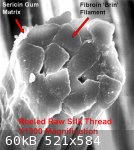
|
|
|
jdowning
Oud Junkie
    
Posts: 3485
Registered: 8-2-2006
Location: Ontario, Canada
Member Is Offline
Mood: No Mood
|
|
Four liquid glue formulations based on Acetic acid are to be tested :
1) Hide Glue/Acetic acid mixture.
2) Gelatin/Acetic acid mixture.
3) Hide Glue/Acetic acid with added Tannin/Borax solution.
4) Gelatin/ Acetic acid with added Tannin/Borax solution.
These will be applied to 20 yarn bundles of degummed 120/2 spun silk - each bundle 99 cm in length twisted 175 turns. This should produce strings of
about 0.60 mm in diameter - equivalent to a Mathna (3rd) string.
Additionally the liquid glues will be applied to 20 yarn bundles that have first been immersed in Tannin/Borax solution for 24 hours+.
This will produce 8 different samples of Mathna strings for individual testing and evaluation.
Furthermore, later an alkaline based liquid glue will also be tested and evaluated giving a total of 16 individual samples.
This could take some time although making the strings is quickly done.
Using 120/2 spun silk it is now possible to estimate the number of yarns required for each string (according to Kanz al-Tuhaf) from data obtained so
far :
Hadd - 0.44 mm diameter - 10 yarns.
Zir - 0.54 mm diameter - 16 yarns.
Mathna - 0.62 mm diameter - 20 yarns.
Mathlath - 0.76 mm diameter - 32 yarns.
Bamm - 0.87 mm diameter - 42 yarns
Once trials on the 16 Mathna strings have been completed and the optimum glue formulation has been determined trial Mathlath and Bamm strings will be
made up and tested.
|
|
|
jdowning
Oud Junkie
    
Posts: 3485
Registered: 8-2-2006
Location: Ontario, Canada
Member Is Offline
Mood: No Mood
|
|
Preparation of the yarn bundles for twisting is a straightforward operation taking only a few minutes using the string winding apparatus details of
which have been posted earlier in this thread.
To facilitate handling of each yarn bundle the yarns are secured to metal hooks (for mounting on the twisting rig) using waxed thread (waxed thread
does not slip). Once secured in this manner each bundle may be handled without the yarns tangling.
For string #1, after mounting on the twisting rig and loading with a weight of 1.84 Kg, the liquid glue was applied to the yarn bundle with a cotton
cloth and then the bundle twisted 175 turns. Surplus glue was wiped off with a cotton cloth and the string allowed to dry on the rig for 24 hours.
To ensure maximum liquidity of the glue, the glue container was set in a pan of warm water for a few minutes before being applied to the yarn bundle.
For strings #2 to #8 (now completed) it was found easier to place the yarn bundle on a plastic sheet, pour a small quantity of glue onto the bundle
and then work the glue into the silk with a small artists paint brush. This ensured full saturation of the bundle with glue.
Each string was then twisted 175 turns with an initial load of 0.4 Kg, all surplus glue wiped off with a paper towel and then the full load of 1.84 Kg
applied. After a final wipe with a cloth, each string was allowed to dry for 24 hours.
The number of turns and loadings are a best guess at the present time so may be subject to modification as experience is gained.
All strings are uniform in diameter and fairly smooth but with some slight roughness to the touch due to some small hairs of silk that were not
smoothed down by the glue. Some additional finishing operation - yet to be determined - may be required to correct this situation.
String #1 was partially untwisted at one end to confirm full saturation of the string by the glue binder (note the little hairs of silk that have not
been stuck down by the glue). It can be seen from the attached image that the string is very flexible.
Now for testing the strings.
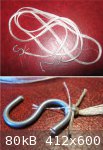
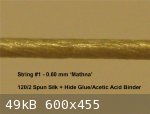
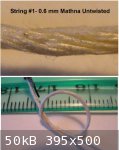
|
|
|
jdowning
Oud Junkie
    
Posts: 3485
Registered: 8-2-2006
Location: Ontario, Canada
Member Is Offline
Mood: No Mood
|
|
The first test is for a Mathna string, 0.6 mm diameter made using a flexible hide glue/acetic acid binder.
All strings will be tested on one of my lutes - a reconstruction of an early 16th C bass lute by Laux Maler that I made in the 1970's. String length
is 73 cm with six courses - the bottom three courses being octave tuned. The lute is currently fitted with 'Pyramid' nylon lute strings in 'D' tuning.
The nylon strings allow the pitch to be raised to 'E' tuning, however, 'D' (at A440 standard) is the proper pitch for all gut and silk stringing.
The test string has been fitted at the sixth course position and tuned to g (196 Hertz frequency at a'=440 standard). The 5th course treble in plain
nylon (0.6 mm diameter) is also at the same pitch with the overspun bass an octave lower (G 98 Hertz) so the performance of the silk test string with
can be directly compared with modern nylon.
String #1 came up to stable pitch quite quickly and has been held at this pitch for 7 days at about 60% Relative Humidity. Assuming silk strings are
similar to gut, the tension of the string at this pitch (using a 'Pyramid' string calculator for convenience) is about 3.2 Kg.
By comparison the nylon strings are at a tension of 2.4 Kg.
The attached sound file (compressed to MP3 so there are some significant audio losses) gives an idea of the relative performance the sequence -
plucking the strings with a fingertip - is nylon overspun bass G then silk g and finally plain nylon g.
Audible sustain for all the strings was about 7 to 8 seconds.
The next step will be to raise the pitch of all strings by a semitone to g#208 Hz to see what happens. String tension of the silk string is about 3.6
Kg at this pitch. The tension of the nylon strings will increase to about 2.7 Kg which is about their optimum tension.
The sound clip was made with a Zoom H2 digital recorder positioned about 60 cm from the lute sound board.
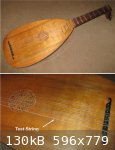
Attachment: String #1 finger tip.mp3 (375kB)
This file has been downloaded 545 times
|
|
|
jdowning
Oud Junkie
    
Posts: 3485
Registered: 8-2-2006
Location: Ontario, Canada
Member Is Offline
Mood: No Mood
|
|
The #1 Mathna string has been raised in pitch by a semitone and after three days is almost stable in pitch.
While the Mathna strings are being tested a trial Bamm string has been made from 42 yarns of 120/2 spun silk using the flexible hide glue/acetic acid
binder. The finished string measures 0.92 mm in diameter - a bit larger than calculated (0.87 mm). This may be reduced when the string is later
polished to eliminate any slight surface roughness.
A second 42 yarn bundle has been left to soak for several days in a saturated solution of copper sulphate. This is to test the possibilities of
'weighting' the bass strings with metallic salts to improve acoustic performance. Silk readily adsorbs metal salts that are used in the weighting and
dyeing of silk fabrics.
It is possible that strings for oud and lute were weighted - as there are some historical references to the strings being coloured (and hence
weighted) by the dyeing process. We do not know if the coloured strings were made from silk or gut (perhaps both - if gut also can be dyed as readily
as silk?).
Ref. 1 - Ziryab, 9th C - " Zir string, yellow; Mathna, red; Mathlath, white; Bamm, black.
Ref. 2 - from an account by Pierre Belon's "Observations de plusieurs singularitez", 1553 - a record of travels through Greece, Egypt, Palestine and
Turkey (see FoMRHI Comm. 25, July 1976). This includes observations on the making of gut strings in Turkey. These strings were used for many
applications including instrument and bow (archery) strings according to the author.
However, it should be noted that the strings most often used by Turkish archers were traditionally made from silk cords - and oud strings were also
made from silk thread - so Belon may have been confused between gut and silk strings (which have similar appearance).
He goes on to note " As for the lute strings, they make all sorts, very fine, and chanterelles (lute top strings) which can go as high (in pitch) as
our own ones; but they are not as silvery (in tone colour?) ..... Such chanterelles are found in many types and colours, red, blue, green, yellow,
white ...."
Ref 3 - Robert Dowland writing about purchasing lute strings in his "Varietie of Lute Lessons", 1610 says that "Some strings there are that are
coloured, out of which choose the lightest colours, viz. among Greene choose Sea-water, of Red the Carnation, and of Blew the Watchet."
Dowland does not say that the strings of his day were made exclusively from gut - most today assume that they were but they could be wrong!
Note that 'Watchet' is old English for a light blue colour.
Also Dowland cautions against strings that are "faseling with little hayres". Not sure what 'faseling' means but the 'little hairs' are surely a
feature of silk (rather than gut) strings that have not been finished smooth. How to properly finish my silk strings (to remove or smooth out any
'little hairs') is something yet to be investigated and perfected.
|
|
|
jdowning
Oud Junkie
    
Posts: 3485
Registered: 8-2-2006
Location: Ontario, Canada
Member Is Offline
Mood: No Mood
|
|
The #1 Mathna string (glue/acetic acid binder) has been mounted on the lute, under tension, at pitch g#208Hz for over a month without signs of
failure. This is a promising result for the acid based liquid glue binders used in this experimental investigation.
In the meantime several strings have been made using various binder/tannin compositions that await testing.
So that comparative, measurable data may be obtained for each test string a rig has been designed that will be completed within the next few days.
This is a simple affair consisting of a sound box with fixed bridge attached, a movable nut - to vary vibrating string length, and a pulley and weight
system to apply a measured load to each test string. This apparatus will allow the testing of up to four strings "in parallel" - although it is
anticipated that two strings tested together for comparison will be the norm. In particular it will allow a comparative assessment of 'weighted'
strings.
Other compositions of liquid glue binder have been made up for testing made from hide glue and gelatin using "saccharate of lime" (sugar and calcium
hydroxide) as a liquefying agent. As with the acetic acid based liquid glue binders, the liquefying agent must be added a little at a time until the
glue remains in a liquid state at room temperature. All very much a trial and error procedure.
|
|
|
jdowning
Oud Junkie
    
Posts: 3485
Registered: 8-2-2006
Location: Ontario, Canada
Member Is Offline
Mood: No Mood
|
|
The new string test rig is now essentially complete apart from a few minor additions.
Made from scrap/recycled materials it is comprised of a solid pine wood frame on which is mounted a simple sound box made from Yellow Poplar with a
Sitka Spruce sound board. The bridge is guitar style with ebony tie block and bone saddle. The nut can be moved to provide a vibrating string length
ranging from 50 cm to 75 cm. Each test string passes from the nut over a plastic pulley where a weight is applied to provide a measured string tension
(ranging from 1.5 Kg to 4 Kg).
Between the nut and pulley each string passes over a small block of UHMW (ultra-high molecular weight) polyethylene - a dense rigid plastic with a
very low coefficient of friction. Not shown in the attached images of the rig is a simple clamp device that will lock each string to the plastic block
during testing.
The sliding nut will also be locked in place with a screw during testing (yet to be added). Although the nut position is infinitely variable, strings
will be tested with vibrating string lengths ranging from 50 cm to 75 cm in increments of 5 cm for convenience.
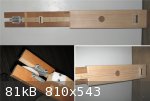
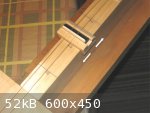
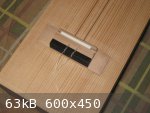
|
|
|
jdowning
Oud Junkie
    
Posts: 3485
Registered: 8-2-2006
Location: Ontario, Canada
Member Is Offline
Mood: No Mood
|
|
After nearly 3 months, have finally found time to run some tests on the first batch of strings made with 120/2 de-gummed spun silk, using acid based,
hide glue binders - as previously reported.
The acid based binders have proven to be resistant to bacterial attack without requiring refrigeration - unlike untreated hide glue or the
experimental alkaline based glue binders that both began to decay after a month.
The acid based glues are also flexible when dry so will be used exclusively for further experimentation.
Preliminary comparative testing is being undertaken on the string test rig in order to measure string sustain and linear density of each string. The
'loading' of a string (due to weight added by the binders) is calculated indirectly by measuring the frequency of vibration and, knowing string
length, diameter and string tension, using the Mersenne-Taylor relationship for vibrating strings to determine the linear density. Alternatively,
weighing each string can only be achieved using an accurate (and costly) analytical balance.
Each string when mounted and loaded with measured weights on the test rig was sounded with a leather 'pick' and the frequency of vibration measured
with a low cost ($10) but effective digital tuner. The sustain of each string was also measured from the instant a string was sounded to the point at
which the tuner pointer returned to zero.
The attached image shows the setup. Here the tuner is indicating a pitch of about C sharp plus 20 cents at A440 standard - equivalent in this case to
a frequency of nearly
140 Hz.
Preliminary results indicate that the glue binder results in a modest loading of the silk from an untreated silk linear density of about 1.2 gm/cc
increasing to an average of about 1.35 gm/cc (measured range 1.25 to 1.45 gm/cc) due to the glue binder composition and loading applied during
twisting of the string.
For comparison, the linear density of a plain mono filament nylon string (Pyramid) was measured on the test rig and calculated to be about 1.14 gm/cc.
String vibration sustain for string lengths between 55cm and 70cm - plain nylon and silk - was relatively consistent, measured at 5 to 6 seconds
duration. String tension on test ranged from 1.5 Kg to 4 Kg in 0. 5 Kg steps and string length from 70 cm to 55 cm in 5 cm steps.
String diameters initially tested were in the range 0.6 mm to 0.66mm (Mathna) and 0.9 to 0.92 (Bamm)
The increasing of string loading due to the glue binder more than compensates for the weight loss in the silk due to removal of the Sericin in the
de-gumming process. Nevertheless, a more significant (and desirable) increase in loading - particularly for bass strings - will necessitate a
different approach.
More to follow.

|
|
|
jdowning
Oud Junkie
    
Posts: 3485
Registered: 8-2-2006
Location: Ontario, Canada
Member Is Offline
Mood: No Mood
|
|
It has been necessary to modify the string test rig because of inconsistent measurements. The main problem was that, due to considerable friction in
the pulley assembly and at the nut, the tension in the string was less than the measured dead weight. This has been corrected by :
1) dismantling the pulley assembly, cleaning and lubricating the bearings so that the pulley wheel freely rotates.
2) raising the pulley wheel level with the nut to eliminate any downward force of the string on the nut.
3) mounting the test rig at an angle of 45 degrees to further reduce loading on the pulley wheel bearing (and hence bearing friction by about 50%).
The modified rig has been 'calibrated' using 'Pyramid' monofilament plain nylon and 'Pyramid' gut with dead loads of 2.5, 3.0, 3.5 and 4 kg. This has
returned consistent results for calculated string density of 1.1 gm/cc for nylon and 1.3 gm/cc. These are reasonably accurate results - to the first
place of decimal - which is about as close as can be expected given this relatively unsophisticated apparatus.
As the objective is to compare the relative densities of the experimental silk strings under test, this level of accuracy will be good enough.
The attached image shows the procedure for calculating string density from the test rig measurements - derived from the basic Mersenne-Taylor Law for
vibrating strings.
Now that the modified rig has been satisfactorily calibrated, the first batch of silk strings will now be retested to determine the calculated string
densities.
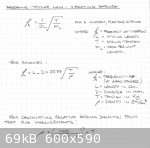
|
|
|
jdowning
Oud Junkie
    
Posts: 3485
Registered: 8-2-2006
Location: Ontario, Canada
Member Is Offline
Mood: No Mood
|
|
With the rig now modified and 'calibrated' the first batch of experimental strings (10 in total) has now been retested. These have all been made from
de-gummed 120/2 spun silk yarn using different flexible glue binders, silk pretreatments, and loadings of the strings during twisting. All just
guesswork at this stage until more experience and data is gained.
Comparative tests have also been undertaken on strings made from filament silk with Sericin binder (made some years ago by Alexander Rakov of New
York) as well as traditional Chinese silk instrument strings of 3 part 'roped' construction.
The purpose is to compare the calculated relative densities of the strings with the objective of finding the best method to maximise string 'loading'
- the greater the density the better (comparing 'like with like' and all else being about equal).
According to research data from the Textile Industries, raw silk has a density of between 1.30 and 1.37 gm/cc whereas that of degummed silk is from
1.25 to 1.3 gm/cc. By comparison plain gut strings have a density between 1.2 and 1.4 gm/cc.
The first step for this first batch of strings has been to add mass by addition of the glue binders as well as by adsorption of Tannin into the silk
fibres and compare the results.
Eight string samples measuring from 0.62 mm to 0.68 mm diameter (under tensions raging from 2.5 Kg to 4 Kg) had calculated densities under test
ranging from 1.0 gm/cc to 1.21 gm/cc. Two string samples measuring 0.89mm and 0.95 mm diameter under the same loading conditions gave a calculated
density from 1.04 to 1.22.
By comparison the Chinese roped string (0.58 mm diameter) gave a calculated mean density of 1.13 gm/cc and Alexander Rakov's string (0.68 mm diameter)
a density of 1.20 gm/cc. The Chinese string also eventually broke at a sustained load of
3.5 Kg demonstrating the relative lower tensile strength of roped construction strings.
All of these results are lower than expected but give some indication of the next direction to take in the quest for increased density. Note that the
calculated density may not be equal to the true density of a string due to factors such as string elasticity. The objective is to eventually double
the calculated density without significantly affecting string elasticity/flexibility.
A long way still to go!
Time now to make a new batch of strings and investigate other string weighting alternatives.
|
|
|
jdowning
Oud Junkie
    
Posts: 3485
Registered: 8-2-2006
Location: Ontario, Canada
Member Is Offline
Mood: No Mood
|
|
As the calculated density will be used as a measure of the relative effectiveness of weighting strings (of the same diameter and construction) so will
the calculated elastic modulus be used as a measure of the relative string elasticity in order to establish the optimum string construction - number
of twists etc. - the greater the string elasticity the better.
The elastic modulus (or Young's Modulus) is a constant value for each material type or composition. It is defined (for a string) as the Stress on a
string divided by the Strain. Stress is the string tension divided by the cross sectional area of the string and strain is the increase in the length
of a string when under tension divided by the original string length when not under tension.
The more elastic or 'stretchy' a material is the smaller the value of the elastic modulus.
The relative elastic moduli for the first batch of experimental strings has been determined using the test rig - each string being tensioned with a
4Kg load and the extension from the unloaded length (67.5 cm) being measured as well as the string diameter when under tension. This is all a bit
'rough and ready' but is intended only to identify order of magnitude changes.
The tests on strings in the diameter range of 0.5 to 0.7 mm indicate that monfilament nylon is the most elastic, followed by plain low twist gut and
medium twist silk filament/sericin followed by the first batch of experimental strings. The plain gut and medium twist silk strings have an elastic
modulus ranging from about 40% to 60% of the low twist experimental strings and the modulus of nylon is about 60% less than the gut/medium twist
silk.
Although the first batch of experimental strings are the most flexible (easy to bend) of the group they are the least elastic (stiffest) - which may
account in part for the unexpectedly low calculated values for density - the stiffer strings vibrating at a relatively higher fundamental
frequency.
So more work need to be done to find the optimum degree of twist per unit length for each diameter of simply twisted silk string. If increasing the
number of twists does not increase string elasticity to, say, the same order as the medium twist silk filament/sericin strings then this might be an
indication that spun silk thread is not the best material for making viable instrument strings.
Time will tell - but at the end of the day, judgment of the acoustic performance of a string lies in the ear of the beholder regardless of the
calculated values of this or that string property.
In this respect, it is of interest to note that the audible 'sustain' of all of the strings tested in batch #1 - nylon, gut, silk - each measured in
the range of around 5 to 6 seconds.
|
|
|
jdowning
Oud Junkie
    
Posts: 3485
Registered: 8-2-2006
Location: Ontario, Canada
Member Is Offline
Mood: No Mood
|
|
Silk strings can be made heavier ('weighted) by the addition of the glue binder as well other materials that are more dense than the silk filament.
Silk will readily adsorb metal salts so the traditional weighting method used by the silk fabric industry is to immerse the silk in a bath of a
metallic salt solution followed by immersion in another salt bath that will react to form an insoluble precipitate of the metal salt either in or on
the silk filament.
Heavy metal salts of tin and lead were commonly used for weighting and reagents creating the desired precipitation can include organic materials such
as gelatin and tannin.
The other method of weighting strings is to simply mix heavy powders with the glue binder - such as copper powder or oxides of iron.
Due to the toxicity of heavy metals (not a problem in earlier times - but lead and mercury are not an option here!), these string weighting trials
will be restricted to the metals tin, copper and iron as well as the organic materials gelatin and tannin. A further restriction is that the weighting
materials or chemicals must have been available to the ancients.
The procedure for making the heavy metal salt Stannous Chloride has been described in a previous post - easily made - and to be used in these
trials.
Next to make fine copper powder - as an additive to the glue binder. Again this is easily made by reacting a Copper Sulphate solution with iron to
form metallic Copper and Ferrous Sulphate.
Here a convenient source of iron is fine grade 'steel wool' readily available from any hardware store (the kind that is oil free - used for finishing
painted surfaces). This is immersed in a saturated solution of Copper Sulphate (blue coloured) and allowed to stand until the reaction is complete.
The heavy metallic Copper falls to the bottom of the container and the green coloured liquid remaining is Ferrous Sulphate (that will be used as
another weighting chemical).
The copper powder is collected by straining the liquid though a fine filter (paper coffee machine filter) and after washing with water allowed to
dry.
The dried powder is then ground up in a mortar and will be sifted through a fine sieve to remove any 'large' residual iron wire particles prior to
mixing with the glue binder.
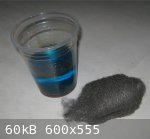
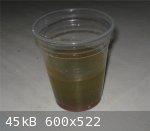
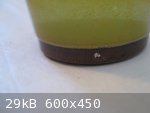
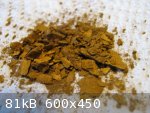
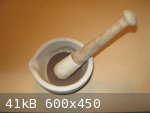
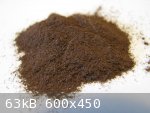
|
|
|
jdowning
Oud Junkie
    
Posts: 3485
Registered: 8-2-2006
Location: Ontario, Canada
Member Is Offline
Mood: No Mood
|
|
Another weighting material that will be tested is iron oxide - readily available and safe. Iron oxide comes in many complex compositions (such as
'rust' that forms on iron in damp conditions) and is widely used in commerce from making iron to paint pigments to cosmetics. It occurs naturally in
minerals such as Hematite that contains over 90% of iron oxide. It is red in colour but other forms of the oxide are coloured black, brown yellow,
green and blue.
The attached image shows a sample of 'red oxide' finely ground and sold as an artist's pigment to colour paint and varnish. The same stuff is also
sold as 'Jewellers Rouge' - a very fine abrasive polish for gold and other metals.
Iron Oxide has a density ranging between about 4 and 5 gm/cc so is about 4X more dense than degummed silk filament. However as Iron oxide and copper
powders will be added to the glue binders for added mass (and not adsorbed by the silk) the possibilty for significant increase in string mass is
likely limited.
The most promising weighting procedure is likely to be by chemical adsorption - as employed by the silk fabric industries. Unfortunately there is
little published information available on details of the procedure, chemicals used etc - probably because this is proprietary information (trade
secret).
For this investigation the weighting chemicals to be tested will be tannin, copper sulphate, ferrous (iron) sulphate and stannous (tin) chloride - all
chemicals (among many others) familiar to the ancients.
For weighting powders - glue binder additives - Iron oxide and copper powders will be tested.
From the batch #1 string tests the glue binders having the greatest elasticity are the acid based liquid glues modified with the addition of tannin
(equivalent to the softening of tanned leather) combined with pretreatment of the silk fibre by soaking in a tannin solution.
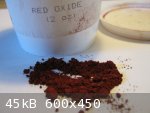
|
|
|
jdowning
Oud Junkie
    
Posts: 3485
Registered: 8-2-2006
Location: Ontario, Canada
Member Is Offline
Mood: No Mood
|
|
The 8 batch #1 test strings (0.62 to 0.68 mm diameter) have now been subject to destructive testing to determine approximate Ultimate Tensile
Strength.
Each string was simply loaded using a spring scale until it broke - repeated twice for each string. The results were fairly consistent regardless of
the composition of glue binder to give an approximate U.T.S. value of 31,000 psi (2180 Kg/cm2).
This is about 40% of the value reported by the textile industries for raw filament silk. The reduced value may be due to the use de-gummed spun silk
rather than continuous filament raw silk, the degree of twist in the fibres of the string and the acidity of the glue binders - all of which may
contribute to a reduction in string breaking strength - particularly the twist factor (more twist = less tensile strength).
These results indicate that strings made from spun silk may not be suitable for making the top two treble courses - for which the stronger filament
silk must be used to avoid frequent breakage under tension
It is interesting to note that the batch #1 experimental strings broke with quite a uniform 'clean break' - a good sign indicating homogeneous
construction of the string - see attached image. On the other hand this may be due to brittle failure of the silk fibres due to acidity of the glue
binder - not so good!

|
|
|
jdowning
Oud Junkie
    
Posts: 3485
Registered: 8-2-2006
Location: Ontario, Canada
Member Is Offline
Mood: No Mood
|
|
Mimmo Peruffo (Aquila strings) - who has pioneered the development of 'loaded' historical gut strings - presents and discusses the historical evidence
in support of his convictions in his paper "The Lute in its Historical Reality" . Very interesting, well presented and easy to understand.
He concludes that fine copper powder is the only practical way to load gut bass strings - so this will definitely be tested in these trials for silk
strings.
Mimmo's paper can be downloaded from
http://www.aquilacorde.com/images/pdf/9e.pdf
|
|
|
jdowning
Oud Junkie
    
Posts: 3485
Registered: 8-2-2006
Location: Ontario, Canada
Member Is Offline
Mood: No Mood
|
|
'Plictho Dell'Arte de Tenori' is a book in four parts about the dyeing of fabrics published in Venice in 1548. The author - Giovan Ventura Rosetti -
provides many formulae for the dyeing of silk in the third part of his book including procedures for stiffening or weighting of silk - of particular
interest here. These include application of Gum Arabic, use of tannins in combination with animal glues, and a pre-tannin soaking followed by a
treatment with an iron salt - all part and parcel of these planned trials for the weighting of silk strings.
The silk strings with the most elastic properties (potentially at least) are those made like a small rope - from 3 or 4 twisted strands . The Chinese
have been making this type of instrument string for centuries and still are today. I have an assortment of these strings purchased over 30 years ago
in London, England as well as some recently purchased by my son on a business trip to the Far East.
The strings are quite stiff (not very pliable), supplied in coils, so are probably made from raw silk with the sericin gum left as a binder (but not
sure about that).
The plan is to use the strings as a basis for weighted 6th and perhaps 5th course bourdons by first de-gumming the strings followed by treatment with
tannin/ ferrous sulphate and using a flexible hide glue binder loaded with iron oxide powder. Alternatively a flexible hide glue loaded with copper
powder will be tested.
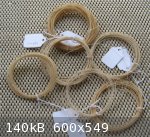
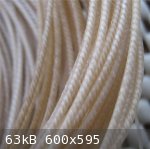
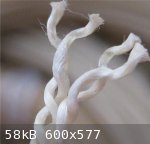
|
|
|
jdowning
Oud Junkie
    
Posts: 3485
Registered: 8-2-2006
Location: Ontario, Canada
Member Is Offline
Mood: No Mood
|
|
As an initial test, a metre length of Chinese 'roped' silk string - measuring 1.1 mm diameter - has been de-gummed prior to being subject to loaded
with Tannin and Ferrous Sulphate solutions.
The length of string was de-gummed - simply tied in a coil and immersed in a solution of Sodium Carbonate (Washing Soda) and dish washing detergent
held at a temperature just below boiling point for 45 minutes. (Alternatively, a solution of wood ash in water could have been used for de-gumming -
more historically correct but less convenient). The proportions of the de-gumming bath were 100 c.c. Detergent, 50 c.c. Sodium Carbonate powder to
3800 c.c. of water (1 U.S. gallon). The coil twisted around itself as the silk absorbed moisture and expanded - as seen in the attached image - but
was easily untangled after de-gumming.
After de-gumming the string was washed in fresh water and left to dry under a nominal load of 0.4 Kg - to ensure that the string remained straight and
uniform without kinks.
The extent of the de-gumming will be assessed tomorrow once the string has dried.
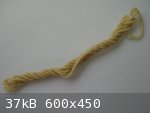
|
|
|
jdowning
Oud Junkie
    
Posts: 3485
Registered: 8-2-2006
Location: Ontario, Canada
Member Is Offline
Mood: No Mood
|
|
The dried string after degumming and under a 0.4 Kg load stretched from 100cm to 102 cm and the nominal diameter reduced from 1.10 mm to 1.02 mm -
most likely due to loss of the Sericin gum - as well as some partial unwinding of the plies of the string. The dried string is very pliable (like a
rope) and white in colour so is probably almost fully degummed.
The string has been immersed in a hot tannin solution for 90 minutes and allowed to remain in the solution for another
4 1/2 hours - then washed in fresh water. The tannin had been adsorbed by the silk to become brown in colour.
The string was then immersed in a hot solution of Ferrous Sulphate for 90 minutes and then washed in fresh water. The string had turned black in
colour due to the reaction between the Tannin and Iron salt forming the complex compound Iron Tannate within the silk (hopefully).
The string has been left to dry under a nominal 0.4 Kg load.
It is interesting to note that the Bamm bass string of a four course oud in Ziryab's time (9th C) was coloured black (the other strings being coloured
white Mathlath , red Mathna and yellow Zir) - suggesting that metal salts may have been used to weight the larger diameter strings at least.
The next step is to treat the dried string with a flexible acidic glue binder to complete the weighting process.
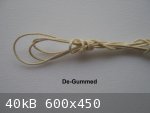
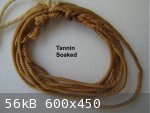
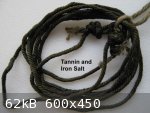
|
|
|
jdowning
Oud Junkie
    
Posts: 3485
Registered: 8-2-2006
Location: Ontario, Canada
Member Is Offline
Mood: No Mood
|
|
After treatment with the acidic glue binder the string diameter was restored to 1.1 mm diameter. The dried string was flexible - not with a brittle
finish like a string made with a Sericin or Gum Arabic binder - but still quite stiff. The string was wrapped several times around a small diameter
rod to improve flexibility and then subject to testing on the test rig. Sustain was modest at about 5 seconds and calculated relative density about
1.14 gm/cc.
Acoustic performance - tested on a lute tuned to E at A440 - as a fifth course bourdon with nylon octave (A 110 Hz at string length 67.5 cm - tension
about 2.5 Kg) - was judged to be poor, lacking in sustain and dull in tone colour (at least compared to modern nylon strings). Disappointing!
The attached image shows the finished string.
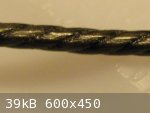
|
|
|
jdowning
Oud Junkie
    
Posts: 3485
Registered: 8-2-2006
Location: Ontario, Canada
Member Is Offline
Mood: No Mood
|
|
Ooops!
Part of the reason for the dull sound when tested on a lute is that both the bourdon and the octave string were tuned in unison! This has been
corrected and the results are more satisfactory but still not ideal. The lute is currently strung throughout with Pyramid nylon - except for the test
string - and has a bright tone with a lot of sustain. This factor together with the octave string at correct pitch is probably essential for an
acceptable acoustic performance of the silk basses (as it would be for plain gut).
On the test rig the string - after 'settling down' under load - showed only 5 mm of elastic extension from no load to 3 Kg tension. Based upon this
result a rough calculation of Young's Modulus for the string showed that its relative modulus of elasticity is about half that of the batch#1 strings
recently tested - about equal to Pyramid plain gut - or about twice that of Pyramid monofilament nylon. Nevertheless significant improvement is still
required to produce a satisfactory silk bass string.
The test string, when being de-gummed and treated, was allowed to unwind to a stable condition but this has resulted in a reduced degree of twist in
the modified string - from about 50 to 30 degrees - with a consequent reduction in the elastic properties of the string (greater degree of twist =
greater elasticity). Another 'roped' string will, therefore, be made using the same treatment, glue binder etc. but after loading with glue and with
the glue still in its liquid state the string will be re-twisted to regain its original degree of twist.
Reduced string elasticity makes a string more sensitive to tuning adjustments (compared to nylon) so, ideally, tuning peg diameter must be kept as
small as possible. The tension on the test string is about 2.5 Kg (determined by trials on the test rig). Lower tensions than this (to achieve a lower
fundamental string frequency or pitch) might cause intonation problems with the thinner octave string due to tension variations as the strings are
stretched over the frets. Also octave tuned string pairs require slightly higher finger pressure to ensure both strings contact the fret when stopped
- again increasing string tension slightly.
Plucking with fingertips requires a slightly different technique than for modern nylon strings. The less slippery surface of the silk basses provides
a better 'grip' to the fingertip. The strings are also relatively smooth so do not 'squeek' under the fingers of the left hand like metal overspun
bass strings.
For information, the attached sound clip is the test string + octave tuned pair plucked together with finger tip - first sounded open and then
progressively stopped as far as the last (7th) fret.
Attachment: STE-016.ogg (452kB)
This file has been downloaded 404 times
|
|
|
jdowning
Oud Junkie
    
Posts: 3485
Registered: 8-2-2006
Location: Ontario, Canada
Member Is Offline
Mood: No Mood
|
|
Silk filament is not perfectly elastic - i.e. once stretched it does not fully return to its original length. The attached plot shows the recovery of
de-gummed silk filament after being stretched under load from its original length of 500 mm to 525 mm. (i.e. 5% extension). When the load is released
the length returns to 508 mm after 15 seconds but the filament then remains permanently stretched to 506 mm.
Gut strings have similar inelastic properties.
Measurements on the test rig to determine string elongation under load were quickly done in order to get some idea of the calculated relative Modulus
of Elasticity (or stiffness - Young's Modulus) of each string under test - order of magnitude for comparison purposes rather than high precision.
For information, Young's Modulus (E) calculated from these test rig measurements - expressed in International Standard units (Gigapascals or GPa - a
unit of pressure) - ranged from an E value of about 6.4 to 8.9 for the 10 batch #1 experimental strings. This compares to a commercial E value for
silk filament of between 8.4 to 12.9 GPa - so the twisted batch #1 experimental strings (made from spun silk and glue) are a bit more elastic than a
string made from untwisted silk filament.
The original Chinese silk 'roped' string had a calculated E value of about 3.5 GPa. For the experimental modified 'weighted' Chinese string the E
value is 4.2 GPa - a bit less elastic than the original due to reduction in degree of twist.
For comparison, historical string maker Eph Segerman (Northern Renaissance Instruments) reports that measured E values for his gut strings range from
about 5 to 6 GPa for low twist plain gut to about 1 to 2 GPa for roped gut strings.

|
|
|
| Pages:
1
..
3
4
5
6
7
..
13 |